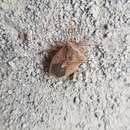Conservation Status
fornecido por University of Alberta Museums
Relatively common.
- licença
- cc-by-nc
- direitos autorais
- University of Alberta Museums
Cyclicity
fornecido por University of Alberta Museums
Adults emerge in June or July and hibernate in September.
- licença
- cc-by-nc
- direitos autorais
- University of Alberta Museums
Distribution
fornecido por University of Alberta Museums
This species is known to occur from Quebec south to Florida and west to Alberta, British Columbia, Idaho and Utah. It is not known from any of the states that border Mexico (McPherson 1982).
- licença
- cc-by-nc
- direitos autorais
- University of Alberta Museums
General Description
fornecido por University of Alberta Museums
Males are elongate and oval, females are broader. Dorsal surface is grayish or a greenish yellow and has many sparse dark brownish gray puncture marks. The edges of the thorax and tip of scutellum are light yellow. Antennae are usually reddish yellow in color and the apical (end) half of the fourth segment and the fifth joint are black. The ventral surface is greenish yellow with small brown spots. The head is longer than wide, with slightly concave cheeks no longer than the clypeus. Sides of pronotum are slightly concave with the edges of the last two thirds finely rippled. The pronotum humeral angles are always acute and are pointed. The apical half of scutellum is smooth with only sparse punctures. Length 11.5-14 mm and width 8-9 mm (Blatchley 1926).
- licença
- cc-by-nc
- direitos autorais
- University of Alberta Museums
Habitat
fornecido por University of Alberta Museums
Field margins and open woodland pastures (Blatchley 1926).
- licença
- cc-by-nc
- direitos autorais
- University of Alberta Museums
Life Cycle
fornecido por University of Alberta Museums
This species is listed as being both univoltine and bivoltine (McPherson 1982). The eggs are light green to cream coloured and shaped like a barrel with a flat top. The head end of the egg is closed with a round lid, which is skirted with 28 to 30 club-shaped spines. There are five instars and the first instar nymphs do not feed (Parish 1934). Adults overwinter under leaf debris and below fence rails (Blatchley 1926). This species has also been known to be a pest on both vegetables and fruit and does cause some damage in orchards (McPherson 1982).
- licença
- cc-by-nc
- direitos autorais
- University of Alberta Museums
Trophic Strategy
fornecido por University of Alberta Museums
This species has been reported on many host plants including grains, grasses and vegetables, and will attack fruit trees when host plants die. This species has even been reported to prey on cottony maple scale insect, coccinellid larvae, pea aphids, and some lepidopteran larvae (Parish 1934; McPherson 1982).
- licença
- cc-by-nc
- direitos autorais
- University of Alberta Museums
Euschistus variolarius
(
Inglês
)
fornecido por wikipedia EN
Euschistus variolarius, the one-spotted stink bug, is a species of stink bug in the family Pentatomidae. It is found in the Caribbean Sea and North America.[1][2][3]
References

- licença
- cc-by-sa-3.0
- direitos autorais
- Wikipedia authors and editors
Euschistus variolarius: Brief Summary
(
Inglês
)
fornecido por wikipedia EN
Euschistus variolarius, the one-spotted stink bug, is a species of stink bug in the family Pentatomidae. It is found in the Caribbean Sea and North America.
- licença
- cc-by-sa-3.0
- direitos autorais
- Wikipedia authors and editors

